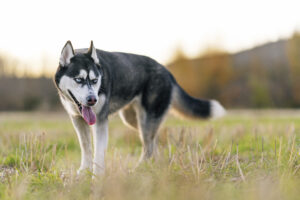Introduction
Doodle dog breeds have taken the pet world by storm over the past two decades. These poodle-mix designer dogs have become incredibly popular for their adorable looks, intelligent nature, and often hypoallergenic coats. While many doodle dog breeds make wonderful companions, not all doodle varieties are created equal, and some may not be the right fit for your lifestyle, experience level, or household situation.
In this comprehensive guide, we’ll explore five doodle dog breeds that might not be the best choice for the average pet owner, despite their appealing qualities. Understanding which doodle dog breeds to avoid can be just as important as knowing which ones would make ideal companions. We’ll also highlight some better alternatives among the many doodle options available today.
Before diving in, it’s important to note that doodle dogs combine the traits of poodles with other purebred dogs, resulting in a wide variety of doodle dog breeds with different characteristics. While this article focuses on potentially problematic doodle varieties, many other doodle dog breeds make excellent pets when properly trained and cared for.
Understanding the Doodle Dog Phenomenon
Doodle dogs are crossbreeds that include poodle genetics, aiming to combine the poodle’s intelligent, low-shedding traits with desirable characteristics from other breeds. The first widely recognized doodle dog was the Labradoodle, created in the 1980s by Australian breeder Wally Conron as a guide dog suitable for people with allergies. Since then, doodle dog breeds have multiplied exponentially, with breeders creating crossbreeds using virtually every popular dog breed with poodles.
The appeal of doodle dog breeds is understandable:
- Many doodle dogs are hypoallergenic doodle breeds or low-shedding doodle breeds
- Their intelligence makes them highly trainable
- Their friendly temperaments often make them great family-friendly doodle breeds
- The various types of doodle dogs come in different sizes, from tiny to large doodle breeds
- Most doodle dogs feature adorable, teddy bear-like appearances
But despite these positive traits, some doodle dog breeds present challenges that make them poor choices for many households. Let’s examine the five doodle dog breeds that might deserve a second thought before bringing them home.
5 Doodle Dog Breeds That Might Not Be Right For You
1. Sheepadoodle (Old English Sheepdog + Poodle)
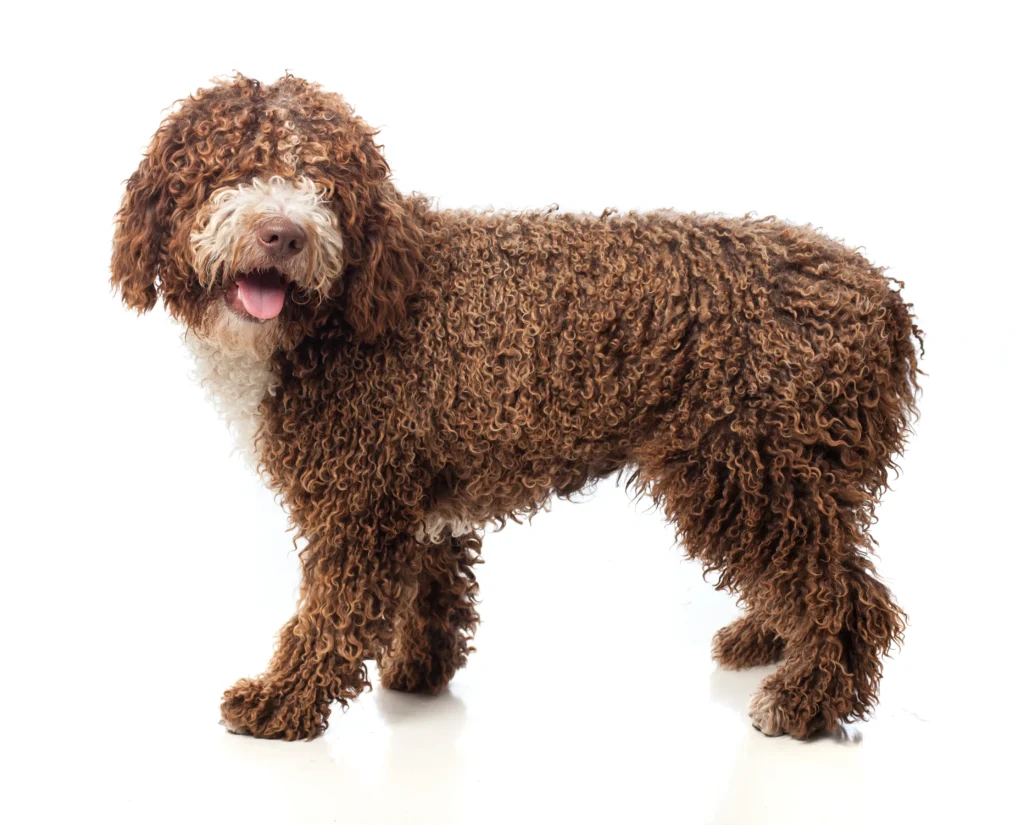
Sheepadoodles are undeniably gorgeous doodle dog breeds with their fluffy black and white coats and teddy bear appearance. Created by crossing Old English Sheepdogs with Standard Poodles, these doodle dogs appear on many “best doodle dog breeds” lists. However, several factors make them challenging for the average owner:
Extreme Energy Levels
Sheepadoodles combine two highly intelligent, high-energy working breeds. Without proper exercise and mental stimulation, these doodle dogs can develop destructive behaviors. They require:
- 1-2 hours of vigorous exercise daily
- Regular mental enrichment activities
- Large spaces to run and play
- Consistent training sessions
For busy families or those living in apartments, meeting these exercise needs can be extraordinarily difficult. While many doodle dog breeds are active, Sheepadoodles take energy to another level.
Intensive Grooming Requirements
Despite being marketed as low-maintenance doodle dogs, Sheepadoodles have one of the most demanding coat care requirements among doodle dog breeds:
- Their thick, dense coats mat easily without daily brushing
- Professional grooming is needed every 6-8 weeks
- Costs for grooming can exceed $100-150 per session
- At-home maintenance requires specialized tools and techniques
Many Sheepadoodle owners report spending 30+ minutes daily on coat maintenance—a significant time commitment compared to other doodle dogs.
Strong Herding Instincts
As a mix of two herding breeds, Sheepadoodles often exhibit strong herding behaviors that can be problematic in family settings:
- Nipping at heels of running children
- Attempting to “herd” family members by body-blocking
- Chasing smaller pets or wildlife aggressively
- Excessive barking when “their” people spread out
While not all Sheepadoodles exhibit these behaviors, the genetic predisposition exists in many of these doodle dogs, making them potentially challenging for households with young children.
Better Alternative: For those seeking a similar look and temperament with fewer challenges, the Bernedoodle (Bernese Mountain Dog + Poodle) offers a calmer energy level while maintaining the fluffy coat and friendly nature many seek in doodle dog breeds.
2. Australian Labradoodle (Multi-generational specialized breed)
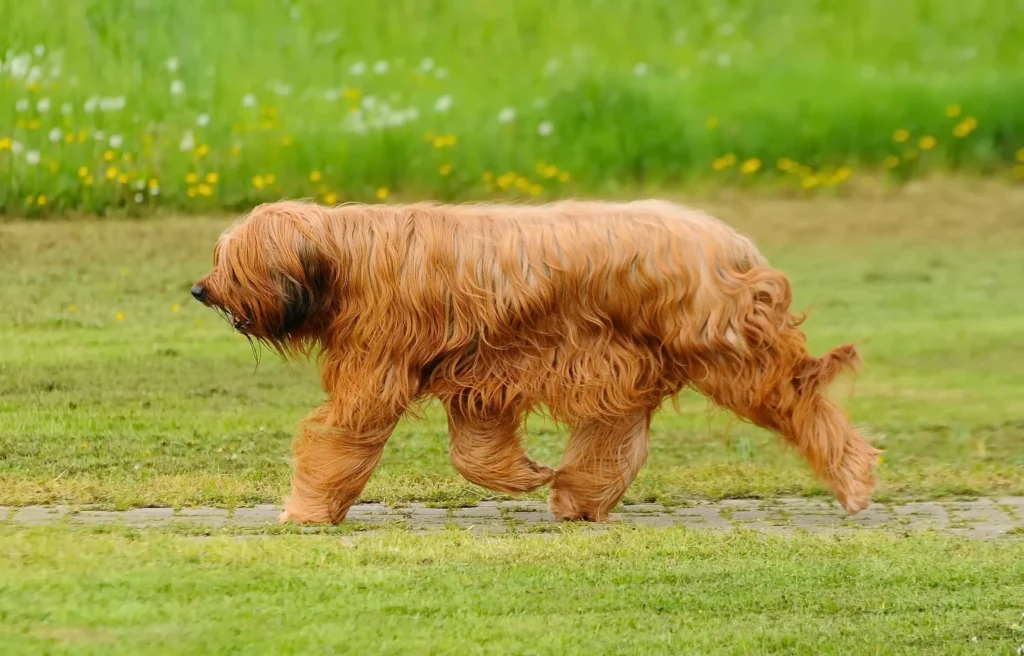
Not to be confused with standard Labradoodles, the Australian Labradoodle is a specific type of doodle dog that incorporates genetics from up to six different breeds: Labrador Retriever, Poodle, American Cocker Spaniel, English Cocker Spaniel, Irish Water Spaniel, and Curly Coat Retriever. While these doodle dogs are often listed among the best doodle dog breeds, several factors make them problematic for many owners:
Unpredictable Traits
The multi-breed background of Australian Labradoodles makes predicting adult traits highly variable:
- Size can range from 14 to 24 inches at the shoulder
- Weight varies dramatically from 15 to 65+ pounds
- Coat types range from straight to extremely curly
- Temperament can favor any of the six contributing breeds
This unpredictability makes it difficult for families to plan appropriately, especially when space or lifestyle constraints are factors. Unlike other doodle dog breeds with more predictable outcomes, Australian Labradoodles can be a genetic lottery.
Health Concerns from Multiple Breed Lines
The complex genetics of Australian Labradoodles expose them to health issues from multiple breed lines:
- Hip and elbow dysplasia (from Labs and Retrievers)
- Progressive Retinal Atrophy (from Poodles and Spaniels)
- Ear infections (from the Spaniel genetics)
- Addison’s disease (from Standard Poodle lines)
While responsible breeders test for these conditions, the sheer number of potential genetic issues makes Australian Labradoodles one of the riskier doodle dog breeds from a health perspective. Veterinary costs can quickly escalate with these doodle dogs.
Extremely High Price Point
Australian Labradoodles are among the most expensive doodle dog breeds:
- Puppies typically cost $3,000-5,000 from reputable breeders
- Import costs can add thousands more
- The high price creates a market for unethical breeders
- Many buyers don’t get the value they expect for the premium price
Combined with the unpredictable traits and health concerns, the extremely high cost makes Australian Labradoodles a questionable choice among the many types of doodle dogs available.
Better Alternative: For those seeking a loyal, friendly retriever-type doodle dog, the standard Labradoodle (Labrador + Poodle) offers many of the same positive traits with greater predictability and typically lower costs.
3. Double Doodles (Doodle + Doodle crosses)

As the doodle dog craze has intensified, some breeders have begun creating “Double Doodles” by crossing two different doodle dog breeds—for example, breeding a Labradoodle with a Goldendoodle. While this might seem like a way to get the best of multiple doodle dogs, these crosses present several significant problems:
Genetic Unpredictability at Extreme Levels
Double Doodles represent one of the most genetically unpredictable doodle dog types:
- Four different purebred breeds influence the genetics
- Coat types can vary drastically even within the same litter
- Size predictions become nearly impossible
- Temperament traits from all four breeds can emerge unpredictably
Even experienced doodle dog owners report being surprised by which traits appear in their Double Doodle puppies, making it difficult to prepare appropriately.
Increased Health Risks
Combining four breeds’ genetic lines concentrates health risks from multiple sources:
- Cancer predispositions from Golden Retrievers and Labradors
- Skin conditions from Poodles
- Joint issues from all contributing breeds
- Autoimmune disorders appearing in unpredictable patterns
Despite claims that hybrid vigor protects these doodle dogs, the reality is that Double Doodles often face more health challenges than simpler doodle dog breeds. This translates to higher lifetime veterinary costs and potential heartbreak for families.
Coat Maintenance Nightmares
Double Doodles often develop what groomers call “combination coats” that include:
- Different textures in different body areas
- Uneven shedding patterns
- Extremely mat-prone areas alongside low-maintenance sections
- Unpredictable adult coat development
Many Double Doodle owners report that these doodle dogs require professional grooming every 4-6 weeks, with costs exceeding $1,200-1,800 annually. This contradicts the low-maintenance doodle dog image many buyers expect.
Better Alternative: Instead of a Double Doodle, consider a second or third-generation single-cross doodle dog like the Goldendoodle or Labradoodle. These more established doodle dog breeds offer greater predictability while still providing the lovable doodle qualities most families seek.
4. Schnoodle (Schnauzer + Poodle)
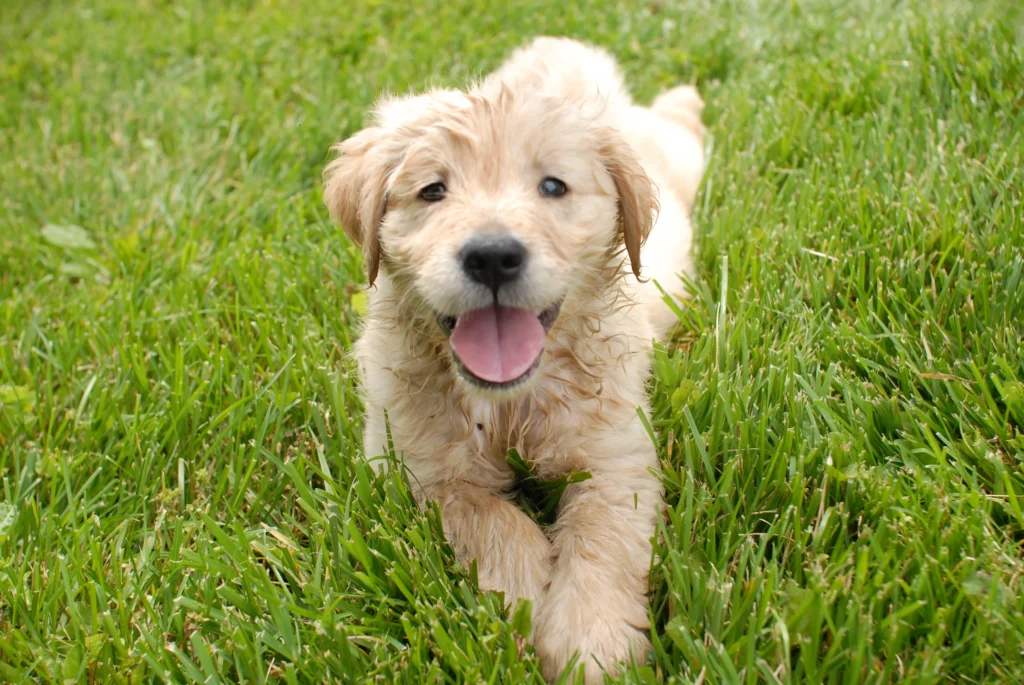
Schnoodles combine the Schnauzer and Poodle breeds, and while they appear on many lists of popular doodle breeds, several characteristics make them challenging companions:
Excessive Barking Issues
Schnoodles inherit vocal tendencies from both parent breeds:
- Schnauzers are known for their alert barking
- Poodles can be vocal when excited or anxious
- Combined, Schnoodles often develop problematic barking habits
- This barking can be difficult to train out completely
For apartment dwellers or those with noise restrictions, Schnoodles can create significant problems, unlike some other doodle dog breeds that tend to be quieter.
Strong Territorial Behaviors
Unlike many family-friendly doodle breeds, Schnoodles often display strong territorial tendencies:
- Suspicion of strangers entering the home
- Protective behaviors that can escalate to aggression
- Difficulty adapting to new people in the household
- Challenges with dog-dog socialization
These traits make Schnoodles less ideal for households with frequent visitors, social gatherings, or changing family dynamics compared to other doodle dogs.
Grooming Complexities
Schnoodles present unique grooming challenges among doodle dog types:
- Their facial hair requires specialized attention to prevent eye irritation
- Their beard area collects food and becomes stained easily
- The combination of wiry Schnauzer and curly Poodle hair creates matting hotspots
- Many develop skin sensitivities requiring specialized shampoos
While all doodle dogs require some grooming, Schnoodles have specific needs that surpass many other doodle dog breeds in terms of complexity and cost.
Better Alternative: For those seeking a small to medium intelligent doodle dog with fewer barking and territorial issues, the Cavapoo (Cavalier King Charles Spaniel + Poodle) offers similar size and intelligence with a typically more easygoing, less vocal temperament.
5. Saint Berdoodle (Saint Bernard + Poodle)
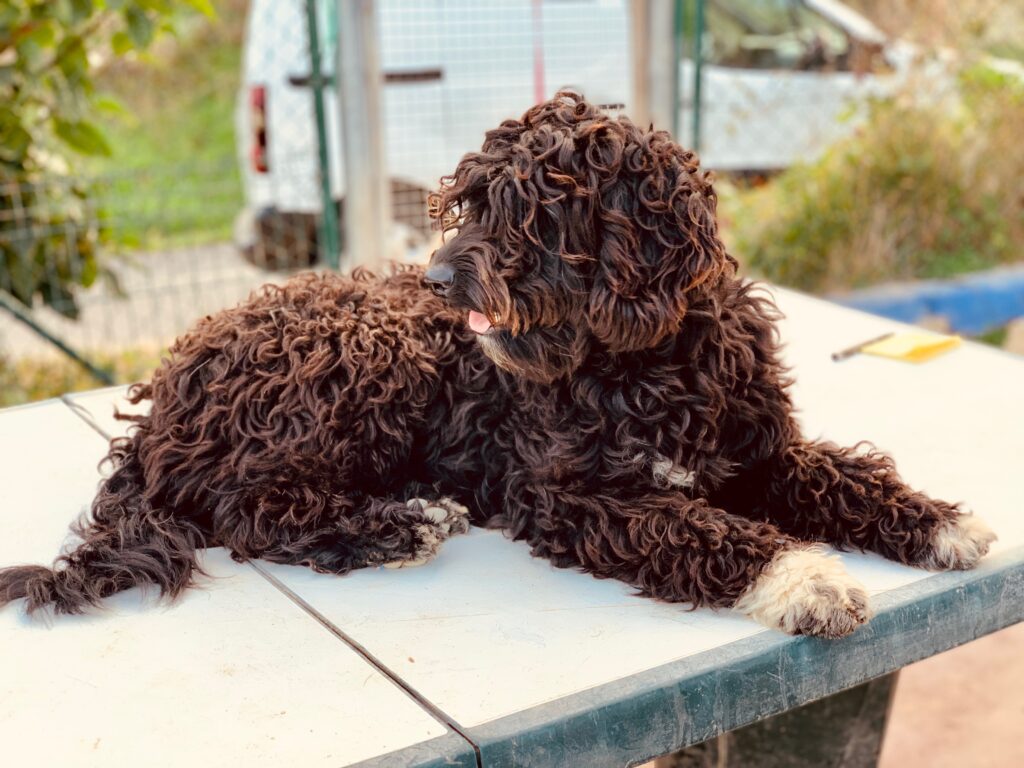
The Saint Berdoodle
represents one of the largest doodle dog breeds, combining the massive Saint Bernard with the Standard Poodle. While these gentle giants can be loving companions, several factors make them inappropriate for most households:
Extreme Size and Associated Costs
The sheer size of Saint Berdoodles creates multiple challenges:
- Adults typically weigh 110-180 pounds
- Food costs can exceed $150-200 monthly for quality nutrition
- Medications and veterinary procedures cost significantly more than for smaller doodle dogs
- Transportation requires specialized vehicles or equipment
- Housing needs include reinforced furniture and extra space
Few families are truly prepared for the logistical challenges that come with one of the largest doodle breeds.
Short Lifespan
Among doodle dog breeds, Saint Berdoodles have one of the shortest lifespans:
- Average life expectancy of just 7-10 years
- Health decline often begins around age 5-6
- Senior care needs start earlier than with other doodle dogs
- Emotional toll of losing a pet after a relatively short time
This shortened lifespan, combined with the deep bonds many families form with their doodle dogs, can create significant emotional hardship.
Health Problems Related to Size
Saint Berdoodles face numerous health challenges related to their large size:
- Joint problems including hip and elbow dysplasia
- Cardiac issues including dilated cardiomyopathy
- Bloat/gastric torsion risk
- Mobility issues developing at relatively young ages
These health concerns translate to high veterinary costs and potential mobility assistance needs as the dog ages, making Saint Berdoodles among the most expensive doodle dog breeds to maintain long-term.
Better Alternative: For those seeking a larger doodle dog with fewer health and lifespan concerns, the Standard Goldendoodle (Golden Retriever + Standard Poodle) offers a more manageable size (50-75 pounds) with a longer average lifespan of 10-15 years.
Better Choices Among Doodle Dog Breeds
Not all doodle dog breeds present the challenges described above. Here are five doodle dogs that consistently rank among the best doodle dog breeds for most families:
1. Miniature Goldendoodle

Miniature Goldendoodles represent one of the most popular doodle breeds for good reason:
- Moderate size (25-45 pounds) fits well in most homes
- Friendly, outgoing temperament ideal for families
- Intelligent and easy to train
- Moderate exercise needs adaptable to different lifestyles
- Excellent track record as family-friendly doodle breeds
As a cross between Golden Retrievers and Miniature Poodles, these doodle dogs offer an excellent balance of traits that work well for most households.
2. Cockapoo

Among small doodle dog breeds, the Cockapoo (Cocker Spaniel + Poodle) stands out:
- Ideal apartment-friendly size (10-30 pounds)
- One of the original doodle dog types with decades of breeding history
- Affectionate and adaptable temperament
- Lower exercise requirements than many doodle dogs
- Typically good with children and other pets
For first-time dog owners or those with limited space, Cockapoos represent one of the most approachable doodle dog breeds.
3. Bernedoodle (Standard)

For those seeking a larger doodle dog with a calm temperament:
- Gentle, easygoing nature makes them excellent family companions
- Moderate energy levels suitable for average active families
- Loyal and affectionate with family members
- Excellent temperament with children
- Considered among the calmest doodle breeds
While Bernedoodles do require regular grooming like most doodle dog breeds, their temperament advantages often outweigh maintenance concerns.
4. Cavapoo

The Cavapoo (Cavalier King Charles Spaniel + Poodle) excels as a companion:
- Small size (12-25 pounds) works well in any living situation
- Exceptionally affectionate temperament
- Low to moderate exercise needs
- Highly adaptable to different lifestyles
- Considered among the most affectionate doodle breeds
Their gentle nature makes them particularly suitable for families with young children or elderly owners seeking a manageable companion.
5. Maltipoo

For those seeking a tiny companion doodle:
- Small size (5-15 pounds) works in any living environment
- Considered one of the best hypoallergenic doodle breeds
- Playful yet manageable energy levels
- Long lifespan of 12-15+ years
- Excellent for seniors or those with limited mobility
As one of the smallest doodle dog types, Maltipoos offer the doodle personality in a highly portable package.
Factors to Consider When Choosing a Doodle Dog
When evaluating which doodle dog breeds might be right for your household, consider these essential factors:
Size and Space Requirements
Doodle dogs come in various sizes:
- Toy doodle breeds: Under 15 pounds
- Mini doodle breeds: 15-35 pounds
- Medium doodle dogs: 35-50 pounds
- Standard/Large doodle breeds: 50-90+ pounds
Be realistic about your living space and lifestyle when choosing among these size categories. Larger doodle dog breeds need more space and typically cost more to maintain.
Energy Level and Exercise Needs
Different doodle dog types have varying activity requirements:
- High energy doodle dogs (like Aussiedoodles): 1-2 hours of vigorous daily exercise
- Moderate energy doodle breeds (like Goldendoodles): 30-60 minutes of daily activity
- Lower energy doodle dogs (like Cavapoos): 20-30 minutes of gentle daily exercise
Choosing a doodle dog whose energy level matches your lifestyle is crucial for both your happiness and the dog’s wellbeing.
Grooming Requirements
All doodle dog breeds require some grooming, but needs vary significantly:
- High maintenance doodle dogs: Daily brushing, professional grooming every 4-6 weeks
- Moderate maintenance doodle breeds: 2-3 times weekly brushing, grooming every 6-8 weeks
- Lower maintenance doodle dogs: Weekly brushing, grooming every 8-10 weeks
Be prepared for the time and financial commitment that grooming requires. While many doodle dogs are low-shedding doodle breeds, this doesn’t mean they’re low maintenance.
Health Considerations
Research the health profiles of both parent breeds when choosing doodle dog breeds:
- Hip and elbow scores of parent dogs
- Genetic testing for breed-specific conditions
- Longevity of the parent breeds
- Health guarantees offered by the breeder
The healthiest doodle dogs come from breeders who prioritize health testing over appearance or profit.
Training and Socialization Needs
While all doodle dog breeds are intelligent, some require more intensive training:
- Highly trainable doodle dogs (like Labradoodles): Respond quickly to positive reinforcement
- Independent doodle breeds (like some Sheepadoodles): May require more consistent training
- Sensitive doodle dogs (like Cavapoos): Need gentle, positive approaches
Most doodle dogs rank among the smartest doodle breeds, but this intelligence must be channeled through proper training and socialization.
Finding a Responsible Doodle Dog Breeder
Because doodle dog breeds are so popular, many irresponsible breeders produce puppies with little regard for health or temperament. When seeking a doodle dog, look for breeders who:
- Perform comprehensive health testing on parent dogs
- Raise puppies in home environments, not kennel settings
- Provide health guarantees and lifetime support
- Ask you questions about your lifestyle and home situation
- Have waiting lists rather than “puppies available now”
- Can introduce you to the puppy’s parents
- Focus on one or two types of doodle dogs rather than many varieties
A responsible breeder will typically charge more for their doodle dog puppies, but this investment pays dividends in health and temperament throughout the dog’s life.
Consider Doodle Dog Rescue
For those open to adopting rather than purchasing a puppy, doodle dog rescue organizations offer wonderful opportunities:
- Many doodle dogs need homes after their original families couldn’t meet their needs
- Adult doodle breeds have established personalities and sizes
- Rescue organizations typically provide medical care before adoption
- Adoption fees are significantly lower than breeder prices
- Many rescue doodle dogs are already trained and socialized
Organizations like Doodle Rock Rescue, IDOG Rescue, and many local rescue groups specialize in rehoming doodle dog breeds that need second chances.
Conclusion
While doodle dog breeds offer many wonderful qualities—intelligence, affectionate temperaments, and often hypoallergenic coats—not all doodle varieties are suitable for every household. By avoiding the five problematic doodle dog breeds highlighted in this article and focusing on options that better match your lifestyle, you’ll increase your chances of a successful and happy relationship with your doodle dog.
Remember that individual doodle dogs within any breed or mix can vary significantly. When possible, meet potential puppies and their parents in person to assess temperament and fit before making a commitment. With proper research, realistic expectations, and commitment to training and care, many doodle dog breeds can make wonderful companions for years to come.
For more information about various doodle dog breeds and other pet topics, explore our other helpful guides at PetsPump:
- Top 10 Most Trainable Doodle Dog Breeds
- Small Doodle Dog Breeds for Apartment Living
- Hypoallergenic Dog Breeds: Beyond the Doodle
- Understanding Dog Nutrition Basics
- Best Grooming Tools for Doodle Dog Owners
References
- American Kennel Club. (2023). Designer Dogs: Understanding the Doodle Craze. Retrieved from www.akc.org
- Veterinary Medical Association. (2024). Health Considerations in Poodle Mix Breeds. Journal of Veterinary Medicine, 45(3), 112-118.
- Doodle Dogs of America Association. (2024). The Complete Guide to Doodle Dog Breeds. Canine Publishing House.
- University of Pennsylvania School of Veterinary Medicine. (2023). Genetic Health in Designer Dog Breeds. Veterinary Genetics Quarterly, 18(2), 45-52.
- International Association of Professional Dog Trainers. (2024). Training Challenges in Mixed Breed Dogs. Training Today, 12(4), 28-35.
American Veterinary Medical Association. (2024). Selecting a Pet: Things to Consider





